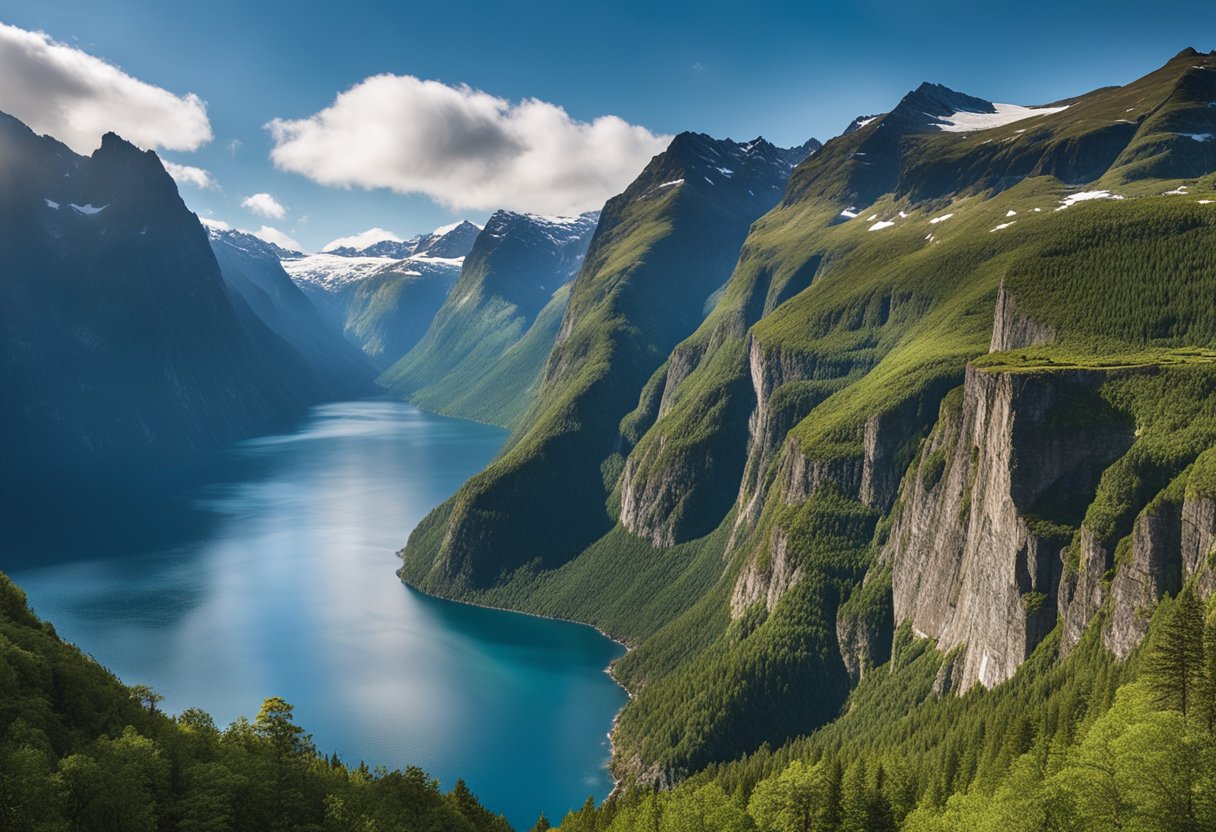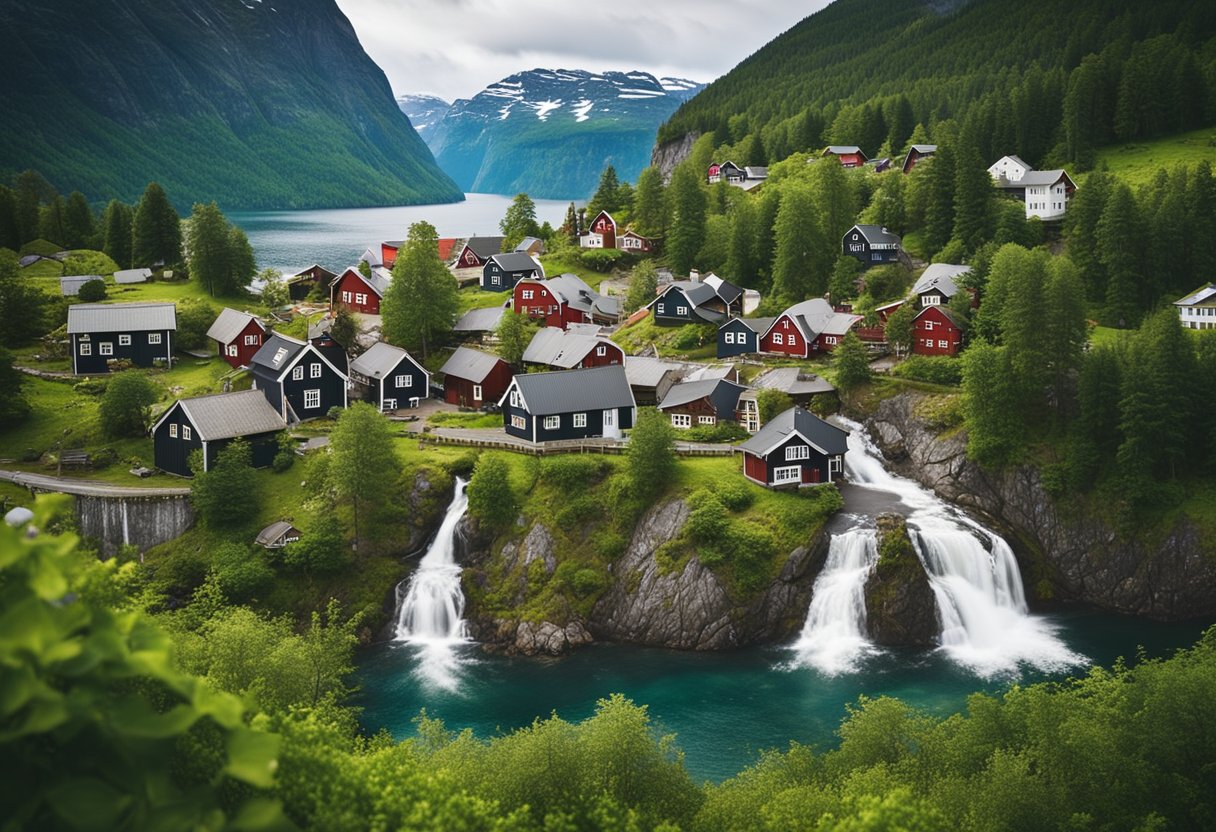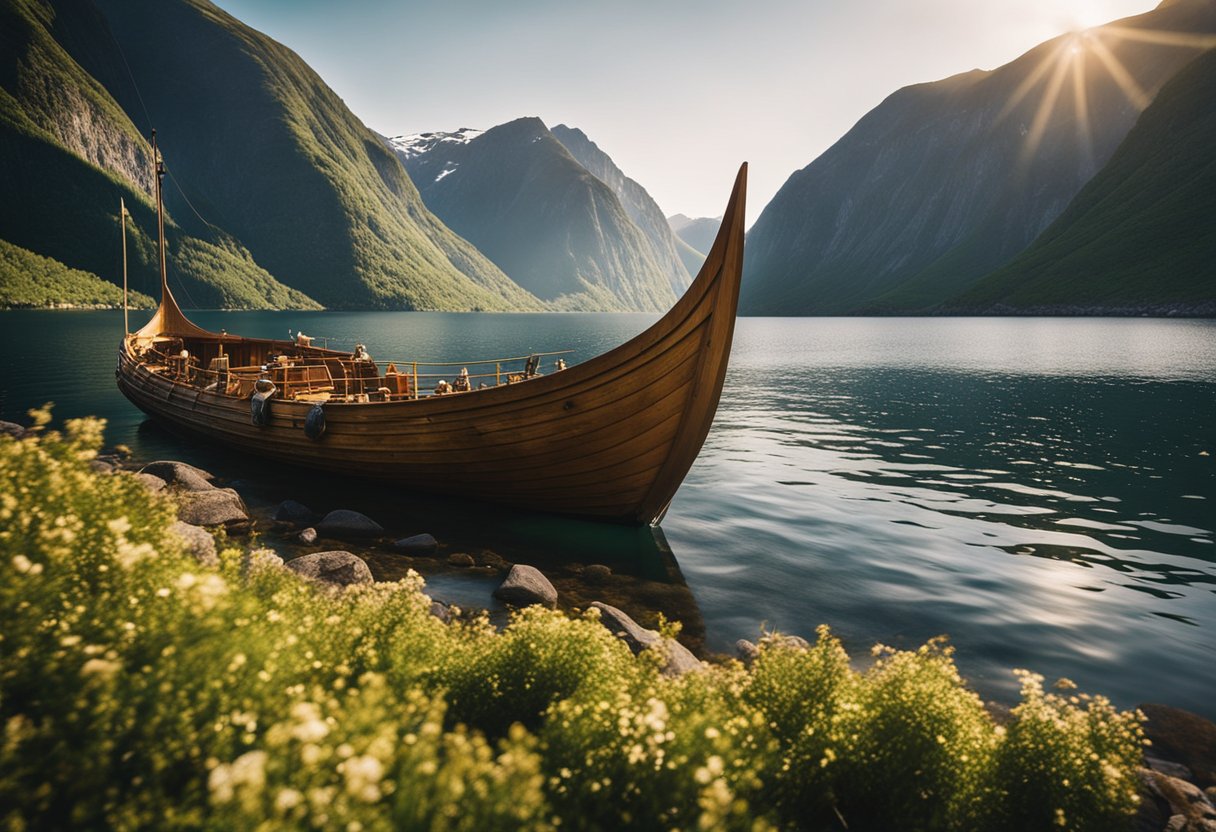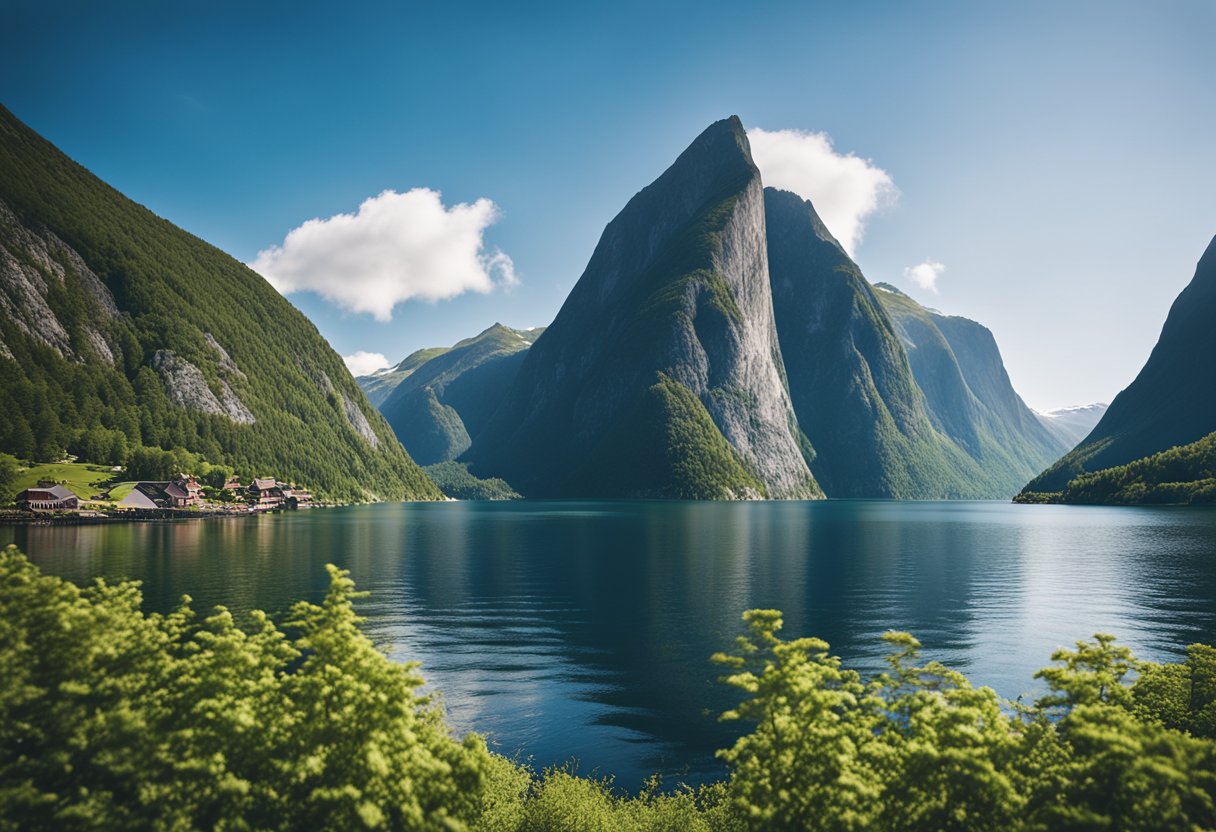The Fjords of Norway: Exploring Viking History Amidst Spectacular Landscapes!

Updated On: April 24, 2024 by Esraa Mahmoud
The fjords of Norway are a testament to the country’s unparalleled natural beauty, where a landscape carved by glacial activity tells a story of geological wonder and historical depth. As we navigate through the serene waterways, soaring cliffs, and rugged coastlines, we behold a world where every turn can reveal a new marvel. The Norwegian fjords stand as silent witnesses to the Viking age, rooted in Nordic culture and legend, creating a sense of awe and connection to the past.

While the fjords are an enduring natural spectacle, the traces of Viking history enrich our understanding of Norway’s heritage. The culture and sagas of the Norsemen are deeply entwined with these landscapes. Today, visitors can experience the convergence of adventure tourism and cultural exploration, with opportunities to see how villages and settlements have maintained their charm and historical significance alongside modern advancements.
The Geographical Wonders of Norway
Norway’s landscape is a patchwork of some of the most dramatic natural features in the world. From towering mountains to awe-inspiring waterfalls, each geographical marvel tells a story as old as the Viking sagas.
Majestic Mountains and Valleys
Norway is home to some of Europe’s most imposing mountain ranges. We find the Jotunheimen range, housing the highest peaks in Northern Europe, where Galdhøpiggen soars into the sky at an impressive 2,469 metres. The Lofoten Islands offer a dramatic backdrop where peaks rise directly from the sea, creating a breathtaking contrast. Equally magnificent are the Norwegian valleys, such as Romsdalen, a prime example of nature’s grandeur with its rugged cliffs and sweeping vistas.
Breathtaking Waterfalls
Our country’s vast rivers and melting glaciers result in majestic waterfalls. Vøringsfossen, with a total drop of 182 metres, is one of the most visited and is a stunning testament to the power of nature. Steinsdalsfossen is celebrated for its beauty and the path behind the waterfall, which allows for an up-close experience of this natural wonder.
Ancient Glaciers
The ancient ice masses of Norway are remnants of the last Ice Age. Jostedalsbreen, the largest glacier on the mainland of Europe, is an expansive ice field that has shaped the landscape for millennia. Glaciers like Briksdalsbreen and Nigardsbreen offer accessible ways to witness these powerful forces of nature, with guided tours allowing them to experience their icy surfaces up close.
These geographical wonders are not just remnants of the past but play a continuing role in shaping the natural beauty of Norway today, leaving visitors in awe of their majesty and the stories they hold.
Exploring Norway’s Fjords
Norway’s fjords offer a breathtaking landscape steeped in natural beauty and Viking lore, where every turn presents a vista more spectacular than the last. Embarking on a fjord tour provides an immersive experience in one of the most stunning natural wonders of the world.
Geirangerfjord and Nærøyfjord
These two UNESCO World Heritage sites are amongst the most picturesque fjords, not only in Norway but globally. Geirangerfjord is known for its deep blue waters surrounded by majestic cliffs and lush greenery. A must-see highlight is the Seven Sisters Waterfall, cascading into the fjord with an impressive drop. In contrast, Nærøyfjord, the narrowest fjord in the world, is famed for its dramatic scenery and towering mountain peaks. These fjords are accessible via boat tours, which offer an up-close view of these spectacular landscapes.
Sognefjord: The King of the Fjords
Sognefjord is Norway’s longest and deepest fjord, aptly nicknamed the King of the Fjords. A journey through Sognefjord extends from the coast to the foot of the Jotunheimen Mountains, exhibiting grandeur at every turn. The arm of the Sognefjord known as Aurlandsfjord is home to dramatic landscapes and cultural experiences, including the picturesque village of Flåm.
The Untouched Beauty of Hardangerfjord
Moving further south, we encounter Hardangerfjord, the second-longest fjord in the country and renowned for its blooming orchards and innovation in Norwegian cider production. This region, often called the orchard of Norway, offers tranquil waters framed by rugged cliffs. In spring, the sight of apple blossoms along the fjord’s steep hillsides is enchanting, complementing the serene landscapes. Hardangerfjord is also a base for exploring the nearby Nordfjord, offering opportunities for hiking and glacier experiences.
Each of these fjords has its unique charm and array of activities, from kayak tours to hiking the surrounding trails. The natural splendour of Norway’s fjords captivates all who visit, leaving a lasting impression of the country’s deep-rooted history and incredible scenic beauty.
Viking History and Culture
As we delve into the fjords of Norway, we will uncover the gripping Viking history and culture, which is as enduring as the landscape itself.
Vestiges of Viking Raids
Viking raids were a significant aspect of Norse culture, with seafaring warriors embarking on voyages from their homeland in search of treasure, trade, and new territories. The Viking Ship Museum showcases well-preserved ships that provide invaluable insight into the craftsmanship and maritime skills pivotal to Viking exploration and conquest.
Norse Mythology and Folklore
Old Norse mythology and folklore are the bedrock of Scandinavian cultural heritage, encapsulating the spiritual beliefs and stories passed down through generations. These tales, featuring gods like Thor and Odin, were central to Viking life and continue to fascinate us with their complexity and depth.
The Legacy of Norwegian Vikings
The influence of the Norwegian Vikings extends beyond their historical raids and maritime prowess. Their cultural heritage has left an indelible mark on Norwegian culture, from language and literature to laws and societal structures that have shaped the nation’s identity throughout the centuries.
Adventure Tourism in Norway
Adventure tourism in Norway offers various activities against its stunning natural landscapes. From the soaring peaks accessible by hiking trails to the deep blue fjords inviting explorers on kayaking adventures, each experience promises a unique connection with nature.
Hiking and Trekking Trails
Norway’s topography is a hiker’s paradise, presenting a wide variety of trails catering to all experience levels. Preikestolen and Trolltunga are two of the country’s iconic hikes, providing breathtaking views over the fjords. For those seeking a multi-day adventure, the Bergen to Myrdal rail line offers access to remote paths through some of Norway’s most awe-inspiring landscapes.
Kayaking and Cruises
Kayaking allows visitors to navigate Norway’s fjords up close, offering a serene and personal encounter with the waterways. Meanwhile, taking a cruise provides a more relaxed mode of exploration, with tours often including stops at quaint villages and opportunities to witness the sheer scale of the fjords from a different perspective.
Winter Sports and Activities
Winter in Norway transforms the fjord landscape into a playground for skiing and other cold-weather activities. Resorts like Hemsedal and Trysil offer excellent slopes for downhill and cross-country skiing. Thrill-seekers might also venture into dog sledging or snowmobiling, which are available in several locations and add another dimension to Norway’s adventure tourism offerings.
Seasonal Spectacles and Activities
Norway’s fjords are a canvas that nature repaints with each changing season, offering many activities and spectacles. From the otherworldly glow of the Northern Lights in winter to the lively wildlife during summer, each season ushers in its unique charm and array of experiences.
Chasing the Northern Lights
Winter in the fjords is synonymous with one of the planet’s most enchanting phenomena: the Northern Lights. As darkness envelops the skies, green, purple, and pink curtains dance above, creating a celestial showcase. This natural wonder is a must, with peak viewing from November to February.
Celebrating Spring and Fall
The melting snow fuels magnificent waterfalls as spring breathes life into the fjords. This is the time to witness the powerful forces of nature as countless cascades, like the awe-inspiring Vøringsfossen, find their full strength. The fjord landscapes transform into a tapestry of vibrant reds, yellows, and oranges in fall. The crisp air and fewer tourists make it ideal for tranquil hikes.
Summer and Wildlife Exploration
Summer unveils a milder climate and invites us for wildlife exploration. The fjords teem with life, from schools of dolphins to herds of reindeer in the highlands. Outdoor activities like kayaking and hiking under the midnight sun allow for intimate encounters with the region’s rich biodiversity.
Norwegian Villages and Cultural Heritage

Norway’s fjords are not just vast natural wonders but also the settings for quaint villages and towns that preserve a rich cultural heritage. These communities are treasure troves of tradition, displaying unique architecture and local customs passed down through generations.
The Charm of Small Villages
In Norway, each small village is a vignette of history, with many nestled between towering mountains and the fjord’s edge. Locals like Balestrand on the northern side of the Sognefjord offer stunning views and a tranquil atmosphere. Here, visitors can stroll through fruit orchards and gardens that paint the village with vibrant hues during the spring and summer months.
From Farming to Fishing Communities
Transitioning from farming to fishing has historically shaped the coastal culture of Norway. Fjærland for instance, has roots in agriculture and a fishing community, where the glacier meets the fjord. Today, these communities balance modernity with tradition, often focusing on sustainable practices to maintain their way of life while attracting conscientious travellers.
Architectural Beauty and Local Traditions
The architectural beauty of Norwegian villages is remarkable, with structures built to withstand the region’s rugged landscape. Influences from Norwegian culture pervade, seen in the dragon-head carvings that nod to Viking craftsmanship or the stave churches that dot the countryside. These buildings are not just functional; they are emblems of Norway’s past, integrated seamlessly into residents’ daily lives, continuing the legacy of their cultural heritage.
Iconic Landmarks and Attractions
Norway’s fjords are adorned with spectacular attractions, merging natural beauty with human feats. Here are some of the must-visit landmarks.
Preikestolen and Trolltunga
Preikestolen (Pulpit Rock) majestically overlooks the Lysefjord and is one of Norway’s most famous tourist attractions. This iconic square plateau boasts a breathtaking view, rising about 604 metres above the fjord. Trolltunga is another remarkable rock formation, jutting out about 700 metres above Lake Ringedalsvatnet, offering one of the most scenic cliffside views in the world.
The Seven Sisters Waterfall
The Seven Sisters cascade is a majestic series of waterfalls, visible from the Geirangerfjord. Legend has it that the Seven Sisters dance playfully down the mountainside, each waterfall representing a sister. Visitors can experience this natural wonder up close, often with the bonus of a rainbow on sunny days due to the spray.
Historic Stave Churches
The Norwegian stave churches are a window into the nation’s medieval past. These wooden masterpieces, with their distinctive multi-tiered roofs and ornate carvings, blend Christianity with Viking-age symbolism. One such church, not far from the fjords, is the Borgund Stave Church, widely regarded for its remarkable preservation and intricate design.
Fjord Navigation and Transportation

Exploring the majestic fjords of Norway offers a unique blend of natural beauty and cultural history seamlessly integrated with modern and traditional transportation methods. Whether by rail, sea, or the time-honoured practice of boating, travellers can navigate these spectacular landscapes to uncover hidden gems and Viking lore.
The Flåm Railway Journey
The Flåm Railway is one of the most scenic train journeys in the world, offering unparalleled views as it winds through the steep and narrow Flåm Valley. We can board the train in Flåm at sea level and ascend to the Myrdal mountain station at 867 meters above sea level in about an hour. This journey reveals the heart of Norway’s dramatic fjord landscapes, regardless of the tourist season, and is accessible throughout the year. The railway’s strategic stops and panoramic windows make it an optimal choice for sightseers.
Navigating with Hurtigruten
Hurtigruten, often referred to as the ‘Norwegian Coastal Express’, is a revered maritime service that expertly navigates the rugged coastlines of Norway. We can experience Norway’s coastal beauty aboard Hurtigruten cruise ships, which act as passenger ferries and cargo vessels, connecting remote villages with larger urban areas. These ships provide a perfect blend of transportation and tourism, offering regular services that accommodate travellers looking for a unique Norwegian coastal journey and locals going about their daily lives.
Modern and Traditional Boating
Boating in the fjords presents various experiences, from modern tours to traditional boating. During the tourist season, various boat tours depart from Flåm and other harbours, granting us an intimate look at the fjords from the water level. We can choose from high-speed RIB boats for an adrenaline-filled adventure or sail on serene, eco-friendly vessels designed to minimise environmental impact. Small, traditional wooden boats are also available for travellers seeking authenticity, allowing us to sail in the wake of the Vikings, using the fjords as they once did.
Arts, Literature, and the Fjord Influence
Exploring the fjords of Norway, one cannot help but observe their profound influence on Nordic arts and literature. This landscape, characterised by stark beauty and dramatic contours, has kindled the imagination of artists and writers, leaving an indelible mark on Norwegian culture.
Art Inspired by Nature
Norwegian art has long drawn upon the country’s natural splendour for inspiration. Artists, captivated by the serene fjords, have created pieces that reflect not just the beauty of the landscape but also its spirit. The intensity of light and shadow, with the shimmering waters against the towering cliffs, is often featured in paintings and photos. This raw, natural elegance of the fjords has been impressively preserved through artists’ lens, immortalising the essence of Norway’s natural heritage.
Literary Works and Drama
The impact of Norway’s fjords on literature extends deep into the national psyche. Playwright Henrik Ibsen, whose work has garnered international acclaim, interwove Norway’s stark realities and myths within his dramas. His masterpiece, ‘Peer Gynt’, for example, traverses the rugged landscapes of Norway, with references to the fjords’ ethereal beauty and formidable nature. Ibsen’s contributions have significantly shaped the identity of Norwegian drama and literature, firmly rooting them within the context of the fjords’ persistent influence.
Music and Performing Arts
In music and the performing arts, the fjords have often set the stage, both literally and metaphorically. Folk music, in particular, echoes the tales of Viking lore and the whispers of the fjord’s waters. Traditional Norwegian music performances commonly draw on the nation’s stunning geography for thematic expression, where the haunting melodies interplay with the majesty of the natural surroundings. These performances encapsulate the soul of the fjords, resonating with the history and legends that have rippled through the ages.
Environmental Factors and Preservation
In discussing the majestic fjords of Norway, we must pay homage to the careful preservation efforts which shield their timeless allure and explore the unique weather patterns that shape their existence.
Weather Patterns and Climate
A climate with plentiful rainfall and mild temperatures sculpts Norway’s fjords. For example, The West Norwegian Fjords benefit from the Gulf Stream’s warm currents, creating a more temperate climate than might be expected at such high latitudes. This climatic influence ensures the survival of a diverse range of flora and fauna, which flourishes around these fjords throughout the year.
Conservation of Natural Sites
Our reverence for these natural wonders has led to concerted conservation efforts. The Norwegian government has enacted policies to preserve the country’s unparalleled landscapes. Initiatives such as stringent regulations on fishing, hunting, and oil exploration are a testament to Norway’s commitment to environmental conservation. By maintaining the integrity of these ecosystems, we ensure that they continue to be a source of national pride and natural heritage.
UNESCO World Heritage Sites
The jewel in the crown of Norway’s natural treasures has to be its two fjords, Geirangerfjord and Nærøyfjord, recognised as UNESCO World Heritage Sites. Their inclusion underscores their global importance and secures a commitment to their preservation. These sites are protected for their aesthetic value and the cultural history they envelop, including remnants of human activity dating back to the Viking Age. This designation helps to protect these irreplaceable landscapes from overdevelopment and maintains their biological diversity for future generations to appreciate and study.
Frequently Asked Questions

This section addresses some of the most common queries about Norway’s majestic fjords and their significance in Viking history and Norse mythology.
What is the significance of fjords in Norse mythology?
In Norse mythology, fjords were often considered to be the work of giants and gods. They were seen as awe-inspiring natural wonders that connected the world of the Vikings to their deities and myths.
Can you share some tips on the best ways to experience the fjords of Norway?
We recommend exploring the fjords by boat or ferry for an up-close experience. Hiking the surrounding trails provides stunning panoramic vistas. Winter visits offer the possibility of witnessing the magical northern lights above the fjords.
How many fjords are there in Norway, and what makes them unique?
Norway boasts over a thousand fjords, each with distinct characteristics. Many are known for their deep blue waters, cliffs, and waterfalls, like the renowned Geirangerfjord and the Nærøyfjord, which are UNESCO World Heritage sites.
In what ways did the fjords impact Viking society and culture?
The fjords were central to Viking life as navigable waterways, facilitating seafaring, trade, and exploration. They also provided sheltered harbours and were integral to the settlement patterns and societal structure of the Vikings.
What are the distinguishing features of Norwegian fjords that attract visitors?
Norwegian fjords are famous for crystal-clear waters, dramatic mountain landscapes, cascading waterfalls, and the captivating interplay of light and nature, which combine to create an ethereal and otherworldly beauty.
How do you correctly pronounce ‘fjord’, and what is its etymology?
‘Fjord’ is pronounced as [‘fee-yawrd], stemming from the Old Norse word ‘fjǫrðr’. The term directly translates to ‘where one fares through’, referring to the navigable travel routes through the sea.






